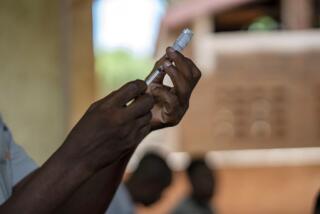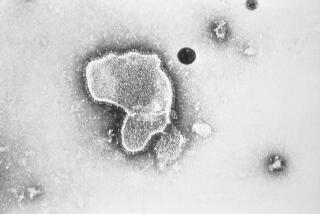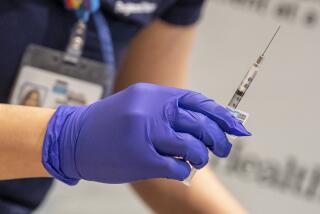MEDICINE IMMUNOLOGY RESEARCH : Strides Made Toward Multipurpose Vaccine for Third World
Researchers have taken a major step toward the development of a single, inexpensive vaccine that could protect Third World children against a variety of life-threatening diseases.
A team headed by molecular biologist Barry R. Bloom of the Albert Einstein College of Medicine in New York City has made a genetically engineered form of the tuberculosis vaccine and demonstrated for the first time that it can produce an immune response in mice against more than one disorder simultaneously--in this case, tuberculosis and tetanus.
The modified vaccine is a prototype for an eventual product that would protect simultaneously against six to 10 diseases. Such a vaccine, the researchers report in today’s issue of the British journal Nature, could save the lives of as many as 8 million Third World children annually who currently are not vaccinated against major childhood diseases.
Modification of the tuberculosis vaccine, which already has been used to treat 2 1/2 billion people, is especially promising because it has virtually no significant side effects. It is cheap, does not require refrigeration (an important feature in the tropics) and provides long-lasting immunity with one inoculation.
“The new results point to an exciting opportunity to provide this tried and tested performer with a new and infinitely variable repertoire,” said infectious-diseases specialist M. J. Colston of the National Institute for Medical Research in London.
“It’s very interesting work. . . . I’m very enthusiastic about it,” added molecular biologist Bernard Moss of the National Institute of Allergy and Infectious Diseases, who is performing similar research.
Bloom predicted that the first human tests of a modified tuberculosis vaccine could be performed in as little as two years, and that it could be broadly available by the end of the decade.
Researchers have been promoting the development of such multipurpose vaccines since the advent of genetic engineering technology a decade ago. The concept is simple: Take a microorganism that has already been proved safe--such as the BCG bacterium used in the tuberculosis vaccine or the vaccinia virus used in the smallpox vaccine--and add genes that will produce proteins characteristic of other disease-causing microorganisms.
When the body is exposed to those proteins after vaccination, it will produce a protective immune response against each disease.
But the progress has been agonizingly slow. One major problem, according to Colston, is that BCG is “particularly difficult” to work with because it is slow-growing. Whereas any given experiment with the bacteria most commonly used in genetic engineering might take 24 hours to conduct, a comparable experiment with BCG can take three to four weeks.
Furthermore, it took researchers many years to develop techniques that allowed the BCG to produce the foreign proteins that are essential to vaccine production. However, Bloom and other researchers have been able to add to BCG genes from viruses, bacteria and parasites that cause 20 different diseases, including measles, infectious diarrhea, meningitis, respiratory disease and schistosomiasis.
Now, Bloom has gone one step further by adding the genes from several different pathogenic proteins to BCG and demonstrating in mice that the vaccine stimulates an immune response against each protein.
Preliminary tests have shown that this immune response will protect mice against a subsequent exposure to tetanus.
The modified vaccine also produced an immune response against the AIDS virus, but there are many more unknowns about AIDS and it is not clear if such a response would be protective in humans. AIDS vaccines cannot be tested in mice because they do not contract the disease.
Bloom and his colleagues are experimenting with dosages and other characteristics of the BCG to maximize protection. They hope to test a BCG vaccine producing proteins from one pathogen--they do not yet know which one--within two years.






